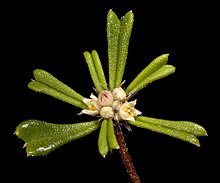Stenanthemum
| Stenanthemum | |
|---|---|

| |
| Stenanthemum nanum | |
| Scientific classification | |
| Kingdom: | Plantae |
| Clade: | Tracheophytes |
| Clade: | Angiosperms |
| Clade: | Eudicots |
| Clade: | Rosids |
| Order: | Rosales |
| Family: | Rhamnaceae |
| Genus: | Stenanthemum Reissek[1] |
| Species | |
|
See text | |
| Synonyms[1] | |
Stenanthemum is a genus of flowering plants family Rhamnaceae and is endemic to Australia. Plants in the genus Stenanthemum are small shrubs usually lacking spines. The leaves are arranged alternately along the branches, simple, usually folded in half lengthwise on a short petiole. The flowers are arranged in dense heads, usually on the ends of branches with bracts at the base of the flowers, and there are sometimes whitish floral leaves. The flowers are bisexual, more or less sessile and have five sepals, five petals and a tube-shaped hypanthium, the petals hooded over the stamens. The fruit is a schizocarp containing spotted or mottled seeds.[2][3][4]


Taxonomy
The genus Stenanthemum was first formally described in 1858 by Siegfried Reissek in the journal Linnaea.[5][6] The genus name means "narrow flower".[7]
List of species
The following is a list of species of Stenanthemum accepted by the Australian Plant Census as at November 2022:[8]
- Stenanthemum arens K.R.Thiele (S.A.)
- Stenanthemum argenteum A.R.Bean (Qld.)
- Stenanthemum bilobum Rye (W.A.) (extinct)
- Stenanthemum bremerense Rye (W.A.)
- Stenanthemum centrale K.R.Thiele (N.T.)
- Stenanthemum complicatum (F.Muell.) Rye (W.A.)
- Stenanthemum coronatum (Reissek) Reissek (W.A.)
- Stenanthemum cristatum Rye (W.A.) (presumed extinct)
- Stenanthemum divaricatum (Benth.) Rye (W.A.)
- Stenanthemum emarginatum Rye (W.A.)
- Stenanthemum humile Benth. (W.A.)
- Stenanthemum intricatum Rye (W.A.)
- Stenanthemum leucophractum (Schltdl.) Reissek (S.A., N.S.W., Vic.)
- Stenanthemum liberum Rye (W.A.)
- Stenanthemum limitatum Rye (W.A.)
- Stenanthemum mediale Rye (W.A.)
- Stenanthemum nanum Rye (W.A.)
- Stenanthemum newbeyi Rye (W.A.)
- Stenanthemum notiale Rye (W.A., S.A., Vic.)
- Stenanthemum patens Rye (W.A.)
- Stenanthemum petraeum Rye (W.A., N.T.)
- Stenanthemum pimelioides (Hook.f.) Benth. (Tas.)
- Stenanthemum poicilum Rye (W.A.)
- Stenanthemum pomaderroides (Reissek) Reissek (W.A.)
- Stenanthemum pumilum (F.Muell.) Diels (W.A.)
- Stenanthemum radiatum Rye (W.A.)
- Stenanthemum reissekii Rye (W.A.)
- Stenanthemum stipulosum Rye (W.A.)
- Stenanthemum sublineare Rye (W.A.)
- Stenanthemum tridentatum (Steud.) Reissek (W.A.)
- Stenanthemum yorkense Rye (W.A.)
References
- ^ a b "Stenanthemum". Australian Plant Census. Retrieved 24 November 2022.
- ^ Walsh, Neville G. "Stenanthemum". Royal Botanic Gardens Victoria. Retrieved 24 November 2022.
- ^ Kellerman, Jürgen; Thiele, Kevin R. Kodela, Phillip G. (ed.). "Stenanthemum". Australian Biological Resources Study, Department of Agriculture, Water and the Environment: Canberra. Retrieved 22 November 2022.
- ^ "Stenanthemum". FloraBase. Western Australian Government Department of Biodiversity, Conservation and Attractions.
- ^ "Stenanthemum". APNI. Retrieved 24 November 2022.
- ^ Reissek, Siegfried (1858). "Plantae Muellerianae Australasicae - Celastrineae, Rhamneae". Linnaea: ein Journal für die Botanik in ihrem ganzen Umfange, oder Beiträge zur Pflanzenkunde. 29 (3): 295. Retrieved 24 November 2022.
- ^ Sharr, Francis Aubi; George, Alex (2019). Western Australian Plant Names and Their Meanings (3rd ed.). Kardinya, WA: Four Gables Press. p. 115. ISBN 9780958034180.
- ^ "Stenanthemum". Australian Plant Census. Retrieved 24 November 2022.
